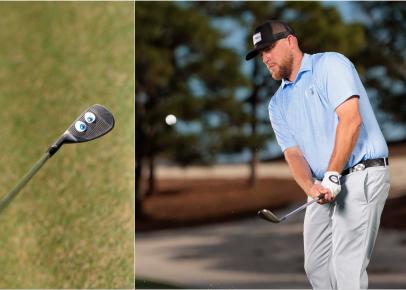Taylor Moore enjoyed a breakthrough season in 2023, capturing his first PGA Tour title at the Valspar Championship and later qualifying for the FedEx Cup’s signature event, the Tour Championship. Yet, Moore’s struggles with the driver in the final two FedEx Cup playoff events left the 30-year-old Texan wondering what could have been.
“He didn’t drive it as well as he could last year, especially at the end of the year,” says Josh Gregory, a performance coach at Maridoe Golf Club in Carrollton, Texas, who works with a number of tour players, including Moore and Will Zalatoris. “It’s still a work in progress, but his ball flight is much straighter now. He should be a top-20 driver of the ball with his speed and length.”
Moore weighs only 160 pounds, but his clubhead speed tops 120 miles per hour and his ball speed “cruises at 180,” Gregory says. If they can get Moore to eliminate the blocks to the right that plagued him late last year, he could dominate off the tee. Moore averaged 307 yards per drive last season.
It didn’t take long for Gregory and Moore to pinpoint the source of his driving issues because it was the same thing that plagued him at the end of his rookie season on tour in 2022. “For whatever reason, I get a little loose with the club at the top of the backswing,” Moore says. “A little too much play.”
The result, Gregory says, is that Moore’s transition and downswing path get too narrow and steep, forcing him to rely on his hands to square the clubface. If his timing is just a little off, then the club sends the ball to the right.
The key to improving the top of the backswing, Moore says, is to focus on the start of the swing. When his left arm separates from his body on the takeaway, that’s when the swing gets long and loose. To fix this, he’ll take out his 7-wood headcover, plug it between his upper left arm and chest, and hit shots trying to keep the headcover in place all the way to the completion of the swing. This tried-and-true method helps keep the left arm connected to the chest long enough to maintain the width and structure of his swing to the top so that he’s more in control. From this shorter, more stable backswing position, with the shaft pointing down his target line (above, fourth image), Moore has an easier time shallowing the club’s path on the downswing and using his body rotation to square the clubface.
“He has plenty of space for his hands to work out away from his right hip and for his body to rotate hard around to the left,” Gregory says. “That’s where he gets his speed.”
Couple this with a patient transition (above, fifth image), which Gregory describes as “keeping the body closed initially,” and Moore can really crush it.
“He’s not trying to add speed early,” Gregory says. “He doesn’t want to step on the gas until later, at the ball.”
More From Golf Digest+  Best Young Teachers Tight lie? No problem! Nip it clean and stop it quickly from the fairway
Best Young Teachers Tight lie? No problem! Nip it clean and stop it quickly from the fairway  In Search of the Greatest Augusta
In Search of the Greatest Augusta  Swing Analysis Want to know what you can steal from Rory’s swing? There’s more than you might think
Swing Analysis Want to know what you can steal from Rory’s swing? There’s more than you might think
This article was originally published on golfdigest.com




